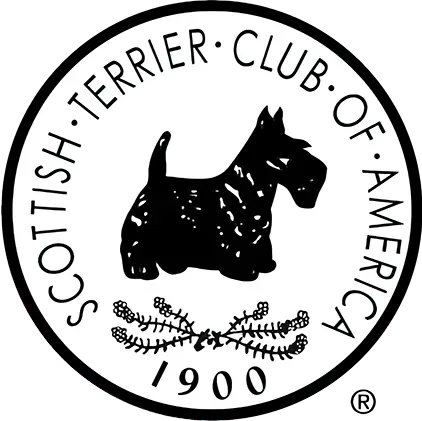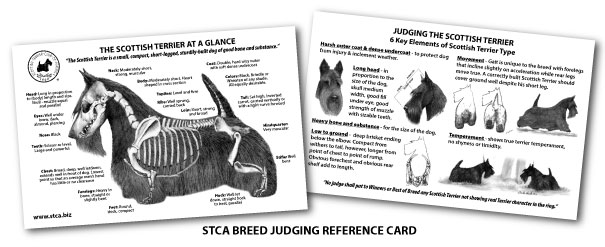Judging Protocol And Scottie Examination
The Scottish Terrier Club of America Officers and Directors wish to reiterate and re-confirm for all judges the proper breed specific examination of the Scottish Terrier. We request that all judges of the Scottish Terrier follow both the AKC protocol for judging and the breed specific examination as described in our standard. This is a table breed and should never be examined on the ground.
Proper examination is essential to your evaluation of the essential characteristics of the breed. The breed standard clearly identifies proper examination of some of the salient features of our breed. The standard is identified below in bold print and expected examination within the standard is bold and underlined.
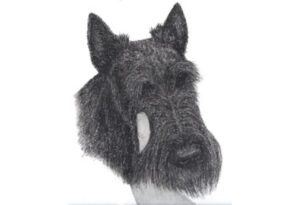 The muzzle should be approximately equal to the length of skull with only a slight taper to the nose. The muzzle should be well filled in under the eye, with no evidence of snippiness. A correct Scottish Terrier muzzle should fill an average man’s hand. Always approach from the front of the dog and reach out and cup the head underneath the muzzle at the same time determining its strength and for a punishing, strong underjaw. Feel under the hair to determine that there is true fill below the dark, almond, wide-set eyes. Never grab the muzzle from the top nor pull on the beard.
The muzzle should be approximately equal to the length of skull with only a slight taper to the nose. The muzzle should be well filled in under the eye, with no evidence of snippiness. A correct Scottish Terrier muzzle should fill an average man’s hand. Always approach from the front of the dog and reach out and cup the head underneath the muzzle at the same time determining its strength and for a punishing, strong underjaw. Feel under the hair to determine that there is true fill below the dark, almond, wide-set eyes. Never grab the muzzle from the top nor pull on the beard.
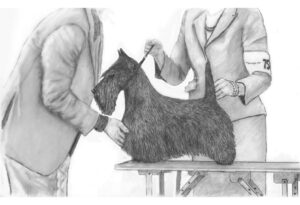 The chest should not be flat or concave and the brisket should nicely fill an average man’s slightly-cupped hand. While at the front of the dog bring your cupped open hand on the chest feeling for the required forechest and prosternum then drop your fingers straight down between the legs to ascertain the relative straightness and width of the forelegs.
The chest should not be flat or concave and the brisket should nicely fill an average man’s slightly-cupped hand. While at the front of the dog bring your cupped open hand on the chest feeling for the required forechest and prosternum then drop your fingers straight down between the legs to ascertain the relative straightness and width of the forelegs.
The lowest point of the brisket should be such that an average man’s fist would fit under it with little or no overhead clearance. Judges should feel for the chest which is described as “broad, very deep and well let down between the forelegs”.
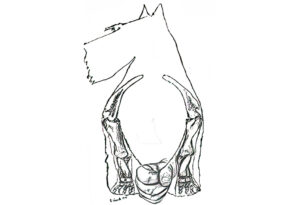
It is a heart-shaped (not slab-sided or barrel-shaped) chest in cross section tapering to a point and dropping down BELOW the elbow.” To properly examine a dog according to the standard the judge should therefore measure width and depth by actually placing his fist under the dog. You may prefer to do this measure from the side just behind the front leg at the deepest rib. If you are tall enough to do so from the front make sure that you do not to place your face in the dog’s and go back to the lowest point under the brisket.
Candidates to judge the Scottish Terrier are strongly encouraged to observe the breed during major entries at the National and/or Regional Specialties. Observers should attempt to observe with a variety of mentors and follow the rules for observations on the AKC website. All prospective judges are strongly encouraged to obtain “The Illustrated Guide to the Scottish Terrier” c2010 from the STCA.
For information regarding presentations on the Scottish Terrier and/or to schedule a ringside observation please contact the STCA Judges’ Education Coordinator.
Kathi Brown, Judges Education Coordinator
Scottish Terrier Coloring
For the novice and the unfamiliar the color black might be an answer. Longtime breeders and knowledgeable terrier judges are well aware that the breed has a coat of many colors, textures and shades. Although this article focuses upon and presents illustrations of some of these colors it is critical to the understanding of the Scottish Terrier that the coat not the color is of greater importance.
Historically Speaking
The Scot has always been a multi-colored breed. Mackie in the early 1880’s visited the highlands to view and record information about Scottish Terriers. It was and is still a purposeful breed and each regional gamekeeper selected and bred dogs for their gameness and ability to rid the area of vermin. Captain Mackie recorded dogs of many colors; red, brindle, fawn, grizzly, black, and sandy. The reports described coats “as hard as any would want” and specifically “rough-coated”. By the year 1880 a committee formed to describe the breed characteristics and the only mention of color was, “white marking objectionable”. The first English Standard (1887) was more detailed and identified a variety of shades of Scottish Terrier as, “Steel or iron grey, black brindle, brown brindle, grey brindle, black, sandy and wheaten. White markings are objectionable and can only be allowed on the chest and to a small extent.” The American Standard (1947) continued to recognize coat color as “steel or iron grey, brindle or grizzled, black sandy or wheaten.” In 1993 the color was changed dropping the grizzle and changing to Black, Wheaten or Brindle of any color. However it is critical that the original colors identified in the earlier standard not be penalized in anyway and that colors, although rarer today, still may and do occur and are acceptable.
Which color is preferred?
No color is preferred over another! An examination of the suggested scale of points clearly conveys the percentage valuing of color in the Scottish Terrier as ZERO. The coat itself however is a salient feature of the breed. Look for, value and reward the Scot that carries the double coat that insulates his sturdy body. Feel the soft dense undercoat and rub the topcoat between your fingers determining its hard, wiry, weather resistant texture essential for the dog’s original purpose. Now reward the coat not the color.
The Scottish Terrier is one of the most instantaneously recognized silhouettes, but the dog himself is much more than a cutout or licorice flavored dog candy. It may be easier to see the outline on a solid dog. The lighter shades may appear larger. Breeders and judges both should select the best Scottish Terrier. Any selective breeding that focuses upon a characteristic over time may produce the desired traits. Color alone is far too simple and may be to the detriment of selecting the best dog and breeding for other critical components.
We all need to choose the best dog of ANY color.
Recently...
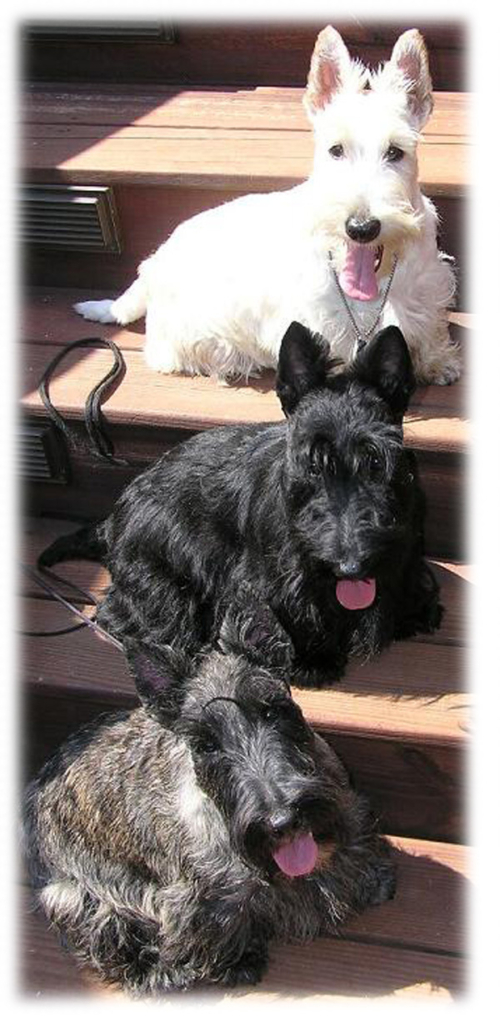 There have been situations in several breeds with unlisted and unacceptable colors being shown. The AKC and affected breed clubs have advised judges to penalize accordingly or excuse for lack of merit. Long-time breeders and judges of the Scottish Terrier are cognizant that our beloved breed has many coat colors. Our Scottish Terriers are still producing the colors described in the breed history and these should not be faulted or penalized.
There have been situations in several breeds with unlisted and unacceptable colors being shown. The AKC and affected breed clubs have advised judges to penalize accordingly or excuse for lack of merit. Long-time breeders and judges of the Scottish Terrier are cognizant that our beloved breed has many coat colors. Our Scottish Terriers are still producing the colors described in the breed history and these should not be faulted or penalized.
It should be noted that genotypically there are many combinations that can and do occur. The basic understanding of dominant and recessive genes is far too simple in predicating the coat color in the Scottish Terrier. Color is polygenic and Little in his “The Inheritance of Coat Color in Dogs” suggests nine genes that can combine and influence its expression within the breed. A visibly black appearing dog may breed as a true black and produce black pups or in fact my produce brindle offspring as a result of carrying a brindle allele. The Scottish Terrier can be solid or brindled, darker or lighter, black, sandy, red, rich reddish wheaten or paler. It can have a dark mask visible on the brindles (although the solid black may also have a mask it is indistinguishable on the dog), brindles may appear in varying depths of color and shades (red, silver, brown, etc.).
Wheaten can appear in any variation from cream through deeper red. Shading on the wheaten is very common as the length and age of the stripped coat and undercoat may influence the color. Even a black dog is not just black but occurs in many tones and shades. White is still allowable to a slight extent on the chest and on the chin which breeders refer to as a milk beard. Upon closer examination of these areas one will find that the white is often a dilute brindle. Often a few white hairs may be found on the body coat with no penalty. Some owners will pluck these and others will leave them as evidence that the dog was not artificially colored for the discerning judge. Infrequently black and tan markings have been known to occur in the breed. Solid reds and sandies are rare but permissible.
Educational Resources
STCA Approved Breed Mentors
All judges’ mentors that meet the STCA Requirements of 15 years experience in Scottish Terriers and have groomed, conditioned and successfully handled 15 dogs to championship status. In addition their dogs have been Winners or better at (2) regional or national specialties.
These mentors have been approved by the STCA Board of Directors. These individuals are available in regions of the United States and are generally available for assistance and ringside mentoring.
In addition to these judges, mentors may observe with other individuals that meet the AKC criteria including approved judges with regular status judging the breed for over 12 years.
